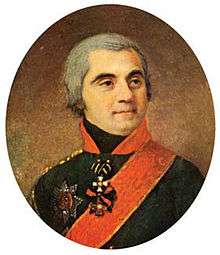Marko Ivelich
Count Marko Konstantinovich Ivelić (1740–1825) was a Serbian born Russian general from Risan who rose to prominence in Russian military service during the reign of Emperor Nicholas I of Russia and Prince-Bishop Petar I Petrović-Njegoš of Montenegro.[1] He became a Russian general and count.
Count Marko Ivelich | |
|---|---|
 | |
| Born | 1740 Risan, Venetian Albania |
| Died | 1825 |
| Allegiance | |
| Service/ | Army |
| Rank | Lieutenant General |
| Wars | Russo-Turkish War (1768–1774) Russo-Turkish War (1787–1792) |
| Awards | Order of St. Vladimir Order of St. Anna Order of St. George |
Ivelich of Risan
An old Risan family, the first Ivelich, according to some sources, settled in Risan at the time of the Nemanjić dynasty.[2] Marko Ivelich had two brothers Ivan Konstantinovich Ivelich, who was a major general in the Imperial Russian army, stationed at Vladikavkaz Garrison Regiment from 1805 to 1810, before he retired; and Semyon Konstantinovich Ivelich, also a high-ranking military officer.[3] His nephew Peter Ivelich fought in the Battle of Borodino and many others against Napoleonic France.
Military career
Marko's education and military career began in the Republic of Venice. There he received the rank of lieutenant before he moved to Imperial Russia. Marko joined the Russian admiral Aleksei Grigoryevich Orlov in 1770 and participated in the fight against the Turks in Boka Kotorska. He was a commander of a part of the Russian Mediterranean fleet. The Russian fleet was under the overall command of Chesmensky, an honorific surname given to Admiral Orlov by Catherine the Great after he defeated the Turkish fleet at the Battle of Chesma, not far from the island of Chios.[4] Marko Ivelić and over a hundred sailors from Boka Kotorska participated in that battle. When the war against the Turks began again in 1788, he was again sent to Montenegro and Herzegovina to stir up the local population; at the same time, he was assigned to form 12 battalions composed of Serbs and other Slavs and to act with them independently. Ivelich successfully completed the task assigned to him and repeatedly defeated the Turks. He became a General of the Russian army in 1800.[4]
In 1805, for the third time sent to Montenegro to induce people to participate in the war against the French.[5] Arriving in the Kotor region after the unsuccessful Battle of Austerlitz, when Venice and the Dalmatian coast were ceded to France by agreement, Ivelich nevertheless managed to arouse the population to resist, which contributed a lot to the success of further actions of Admiral Dmitry Senyavin's Second Archipelago Expedition.[6][7] In 1812, Marko was sent with a diplomatic mission to Wallachia and then contributed to the conclusion of peace between the Turks and Serbs.[8][9]
In 1814, Ivelich became a senator and an officeholder in the Russian-American Company.[10]
See also
- Peter Ivanovich Ivelich
- Andrei Miloradovich
- Jovan Horvat
- Nikolay Depreradovich
- Ivan Adamovich
- Ilya Duka
- Ivan Lukačević (soldier)
- Jovan Tekelija
- Matija Zmajević
- Marko Ivanovich Voinovich
- Jovan Albanez
- Jovan Šević
- Simeon Piščević
- Semyon Zorich
- Georgi Emmanuel
- Anto Gvozdenović
- Mikhail Miloradovich
- Pavle Julinac
- Dmitry Horvat
- Nikolai Dimitrievich Dabić
- Nikolai Kuznetsov (admiral)
References
- Portrait of Marko Ivelich by sea-painter Vasilije Ivanković: https://www.museummaritimum.com/elementi/slike/ivelic2.jpg
- Damnjanović, Nebojša; Merenik, Vladimir (2004). "The first Serbian uprising and the restoration of the Serbian state".
- "MUSEUM MARITIMUM-Kotor, Montenegro".
- Michel. "наполеон и революция: Ивелич Семён Константинович".
- radio, Skala. "Veljko Ćatović: General Marko Ivelić (1740 – 1825) - Skala radio".
- Vehse, Carl Eduard (1896). Memoirs of the Court and Aristocracy of Austria. H. S. Nichols. p. 345.
ivelich, russian generals.
- Jones, David R. (1984). The Military-naval Encyclopedia of Russia and the Soviet Union. ISBN 9780875690285.
- Jones, David R. (1984). The Military-naval Encyclopedia of Russia and the Soviet Union. ISBN 9780875690285.
- Király, Béla K.; Rothenberg, Gunther Erich (1982). War and Society in East Central Europe: The first Serbian uprising 1804-1813. ISBN 9780930888152.
- Petrovich, Michael Boro (1976). "A history of modern Serbia, 1804-1918".
- Okunʹ, Semen Bent͡Sionovich (1979). The Russian-American Company. ISBN 9780374961435.